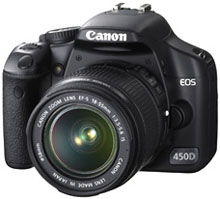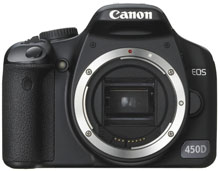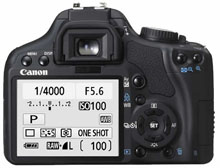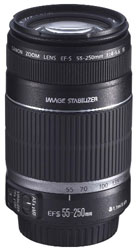
Some of our regular readers may know that I have made occasional references to my interest in photography. After a few years of letting work take over my life and getting by with nothing but my mobile phone camera, I finally decided on an entry-level DSLR to ease my way back into the hobby. For my birthday this year I was given a Canon EOS 450D with a twin lens kit.
It has been 5 years since Canon first released the first “affordable” digital SLR in the form of the EOS 300D (Digital Rebel), the EOS 450D also known as the Rebel XSi (US) and Kiss X2 Digital (Japan), is the fourth generation Canon DSLR at the lower end of the EOS range. I am going to refer to it as the EOS 450D, the name by which it is marketed in Australia.
This is not intended to be a complete technical review of the Canon EOS 450D. There are plenty of professional photographers out there who can provide far more technical details and comparisons. This is intended as an overview of my impressions as an owner and user of an EOS 450D.
Look and Feel
When one enters DSLR territory, you are inevitably moving away from a camera that you can just put in your pocket. Despite that caveat, the EOS 450D is quite compact and at 475 g (1.0 lb) without battery and lens it is not a huge burden to carry around.
The hand grip comprises the majority of the right side of the camera and is covered in a textured rubberised material. There is a slight protrusion at the top of the grip where your forefinger would rest naturally. On the back of the camera is a matching pad for the thumb rest. I could comfortably fit three fingers onto the grip with my little finger half on but for extra large hands it  may be a tighter fit. In my natural ‘shooting’ grip, I have my little finger resting underneath the camera, with my middle and ring fingers resting on the rest and index finger on the shutter release, and I found that that I could hold the camera in that position all day without much trouble.
may be a tighter fit. In my natural ‘shooting’ grip, I have my little finger resting underneath the camera, with my middle and ring fingers resting on the rest and index finger on the shutter release, and I found that that I could hold the camera in that position all day without much trouble.
The shutter release is mounted on top of the grip and positioned at an angle to match the natural bend of my index finger. It really makes life easy for the photographer when everything just sits in the right place. Naturally a lot depends on the photographer’s hand size but this one suited me pretty nicely.
On the right of the viewfinder is a tiny dioptre wheel. A dioptre in the camera is used to focus the image for a user who normally requires corrective glasses to use the viewfinder without needing to wear them. On the EOS 450D, despite its size is still quite easy to adjust, with the added help of a clicking sound to help indicate that the wheel is moving. Although it may vary depending on your shooting style, I would expect that once set, it would be rarely need to be changed. Personally I have never used the dioptre on any of my cameras.
Construction
The EOS 450D is primarily made from three materials. The chassis is made of stainless steel and the mirror box is of high-strength plastic. Both are encased in lightweight plastic which also provides some electromagnetic shielding. The construction is solid despite it being at the lower end of the EOS range. There are no creaks or rattles, nothing twists or buckles on this body.
Controls
The back of the camera is dominated by a 3-inch LCD. The screen is larger than previous models but the resolution remains at 230,000 pixels. The viewing angle is fairly wide with a good contrast ratio. Also located on the back of the camera are controls which provide feedback via the LCD screen, vis-a-vis through the view finder.
 The Command Dial which controls the primary basic functions of the camera sits on top of the hand grip near where my thumb rests, making it a snap to change the shooting mode that I want to be in. Aside from the auto mode, the EOS 450D has 6 pre-set ‘point and shoot’ modes similar to a compact digital camera. Then there’s the creative zone of program, aperture priority, shutter priority, manual exposure, as well as the ‘A-Dep mode’ which automatically maximises depth of field. Shutter speed and aperture settings are adjusted via the data entry wheel located just above the shutter button.
The Command Dial which controls the primary basic functions of the camera sits on top of the hand grip near where my thumb rests, making it a snap to change the shooting mode that I want to be in. Aside from the auto mode, the EOS 450D has 6 pre-set ‘point and shoot’ modes similar to a compact digital camera. Then there’s the creative zone of program, aperture priority, shutter priority, manual exposure, as well as the ‘A-Dep mode’ which automatically maximises depth of field. Shutter speed and aperture settings are adjusted via the data entry wheel located just above the shutter button.
Anyone who has a passing interest in photography would know that part of the process is getting to know your camera and have it become an extension of yourself. That way you have a better chance of catching that fleeting moment without having to look at the camera itself and in order to adjust the dials and buttons. As such the EOS450D design of intuitive and easy-to-reach controls assists the process. The other part of the process is knowing just how your camera and lens combination performs with different apertures, f-stops, shutter speeds, filters etc.
Another key feature I look for in a camera is the shooting speed. There is nothing more frustrating than knowing I have a chance for a great shot and not be able to take multiple exposures to pick the best of the lot. In the EOS 450D, the continuous mode can fire-off a very respectable 3.5 shots per second. In single shot mode, the camera can keep up as fast as you can press the shutter button. The ultra fast nine-point autofocus system and virtually no shutter lag puts in a great performance which makes it ideal for wildlife photography, or in my case, the faster-than-a-speeding-bullet 2 year old niece!
Live View
All new in the Canon entry level DSLR is the ‘Live View function’, which makes it very competitive in its field, and also is one of the reasons for the larger LCD screen. The function is activated by the centre ‘Set button’ within the Cross Keys. This flips the reflex mirror up, activates the image sensor and provides a through-the-lens view on the LCD screen. The unfortunate side effect of this mirror movement is that it disables the use of the main autofocus sensors which are mounted in the viewfinder light path. A secondary contrast detection autofocus system is used for the Live View function but it is slower and suffers in low light conditions. As a result the Live View shooting more useful in a fully controlled environment such as a photography studio.
Personally I have only used the Live View function once – for the Jabra SP700 review where I could not put my eye up to the camera for the shot I wanted! I am more of an old school shooter preferring to take the shots in manual mode looking through the eyepiece and reviewing them when there is a break.
Image Quality
 There are so many factors affecting the image quality of a camera. The 12.4 megapixel CMOS sensor at the heart of the EOS 450D is new and is teamed with a Digic III processor which handles the sensor’s data in 14-bit. Except for the first few days when I was getting used to the camera, I pretty much shoot exclusively in RAW mode (not available in point-and-shoot preset modes). There is a penalty to be paid in frames per second but the unparalleled ability to post-process the images is worth the price. I found that the default JPEG mode tends to underexpose by one stop particularly in bright light conditions.
There are so many factors affecting the image quality of a camera. The 12.4 megapixel CMOS sensor at the heart of the EOS 450D is new and is teamed with a Digic III processor which handles the sensor’s data in 14-bit. Except for the first few days when I was getting used to the camera, I pretty much shoot exclusively in RAW mode (not available in point-and-shoot preset modes). There is a penalty to be paid in frames per second but the unparalleled ability to post-process the images is worth the price. I found that the default JPEG mode tends to underexpose by one stop particularly in bright light conditions.
In terms of noise control, up to ISO 400 the Canon 450D does a great job at balancing detail and noise reduction. At ISO 800 the noise is more noticeable, and even more so at ISO 1600 which is the maximum in auto setting mode. The noise pattern however bears a resemblance to film grain so it is not entirely detracting from the overall image.
Canon has always maintained the position that image stabilisation works best when installed in the lens. According to Canon, “The advantages of IS in the lens are, first, that each IS system can be designed and optimised for its specific application, yielding a level of performance unattainable by the in-body, shifting sensor technique. Second, one can see the image stabilisation effect in the finder. The image is steady; accurate framing is possible; the AF point can be placed precisely, and the photographer can concentrate on the shot and capture the best moment. Panning is also easier and more effective than with the in-body approach.”
With that in mind, the other part of the image quality equation comes down to the lens. While there is no perfect lens, but there is a clear distinction between a good quality lens and an average quality one. My EOS 450D came with an EF-S 18-55mm f/3.5-5.6 IS and an EF-S 55-250mm f/4-5.6 IS, both quality lenses for the price range and entirely adequate for someone starting out in DSLR. Both these lenses have reasonable center sharpness, although there is noticeable barrel distortion on the wide end and some pin cushioning in the long end. The upside of these value-priced lenses is in their weight and portability, with the standard zoom lens coming in at only 200g and the telephoto zoom at 390g.
Specifications
Sensor
* 12.2 million effective pixels
* 12.4 million total pixels
* 22.2 x 14.8 mm CMOS sensor
* RGB Color Filter Array
* Built-in low-pass filter with self cleaning unit
* 3:2 aspect ratio
Dust reduction
* Low-pass filter vibration at power-on (can be interrupted)
* Anti-static coating on sensor surfaces
* Software based dust-removal (camera maps dust, removed later)
Image sizes
* 4272 x 2848 (L)
* 3088 x 2056 (M)
* 2256 x 1504 (S)
Output formats
* RAW (.CR2 14-bit *)
* RAW (.CR2 14-bit *) + JPEG Large/Fine
* JPEG (EXIF 2.21) – Fine, Normal
Image processor
* DIGIC III
Lenses
* Canon EF / EF-S lens mount
* 1.6x field of view crop
Focus modes
* Auto Focus
* Manual Focus (switch on lens)
Auto Focus
* 9-point CMOS sensor
* Cross-type F2.8 at center
* AF working range: -0.5 to 18 EV (at 23°C, ISO 100)
AF modes
* AI Focus
* One shot
* AI Servo
AF point selection
* Auto
* Manual
AF assist
* Flash strobe
Shooting modes
* Auto
* Program AE (P)
* Shutter priority AE (Tv)
* Aperture priority AE (Av)
* Manual (M)
* Auto depth-of-field
* Portrait
* Landscape
* Close-up
* Sports
* Night portrait
* Flash off
Metering
* TTL 35-zone SPC
* Metering range: EV 1.0 – 20 EV (at 23°C, ISO 100, 50 mm F1.4)
Metering modes
* Evaluative 35-zone
* Partial 9% at center
* Spot 4% at center
* Center-weighted average
AE Lock
* AE lock button
AE Bracketing
* +/- 2.0 EV
* 0.5 or 0.3 EV increments
Exposure compensation
* +/- 2.0 EV
* 0.5 or 0.3 EV increments
Sensitivity
* Auto (100 – 400)
* ISO 100
* ISO 200
* ISO 400
* ISO 800
* ISO 1600
* Highlight tone priority * (ISO 200 – 1600)
Shutter
* Focal-plane shutter
* 30 – 1/4000 sec (0.5 or 0.3 EV steps)
* Flash X-Sync: 1/200 sec
* Bulb
Aperture values
* F1.0 – F91 (0.3 EV steps)
* Actual aperture range depends on lens used
White balance
* Auto
* Daylight
* Shade
* Cloudy
* Tungsten
* Fluorescent
* Flash
* Custom
WB Bracketing
* +/-3 levels
* 3 images
* Selectable Blue/Amber or Magenta/Green bias
WB fine-tuning
* Blue (-9) To Amber (+9)
* Magenta (-9) to Green (+9)
Color space
* sRGB
* Adobe RGB
Picture style
* Standard
* Portrait
* Landscape
* Neutral
* Faithful
* Monochrome
* User 1
* User 2
* User 3
Custom image parameters
* Sharpness: 0 to 7
* Contrast: -4 to +4
* Saturation: -4 to +4
* Color tone: -4 to +4
* B&W filter: N, Ye, Or, R, G
* B&W tone: N, S, B, P, G
Drive modes
* Single
* Continuous: 3.5 fps up to 53 JPEG / 6 RAW frames
* Self-timer 10 secs (2 sec with mirror lock-up)
* Self-timer continuous
Mirror lockup
* Yes (custom function)
Viewfinder
* Pentamirror
* 95% frame coverage
* Magnification: 0.87x (-1 diopter with 50 mm lens at infinity)
* Eyepoint: 19 mm
* Dioptric adjustment: -3.0 to +1.0 diopter
* Fixed precision matte
* Proximity sensor disables LCD shooting mode information
Viewfinder info
* AF information (AF points focus confirmation light)
* Shutter speed
* Aperture value
* ISO speed (always displayed)
* AE lock
* Exposure level/compensation
* Spot metering circle
* Exposure warning
* AEB
* Flash ready
* High-speed sync
* FE lock
* Flash exposure compensation
* Red-eye reduction light
* White balance correction
* SD card information
* Monochrome shooting
* Maximum burst
DOF preview
* Yes, button
LCD monitor
* 3.0″ TFT LCD
* 230,000 pixels
* Wide viewing angle (160° horizontal and vertical)
* 7 brightness levels
* Up to 10x zoom playback
LCD Live view
* Live TTL display of scene from CMOS image sensor
* 100% frame coverage
* Real-time evaluative metering using CMOS image sensor
* Best view or exposure simulation
* Grid optional (thirds)
* Magnify optional (5x or 10x at AF point)
* Optional Auto-focus with mirror-down / mirror-up sequence
* Two modes; normal and quieter
* Remote live view using EOS Utility 2.0 (via USB or WiFi/Ethernet using WFT)
* Manual focus only
Camera settings display
* Shutter speed
* Aperture
* Sensitivity (ISO)
* Exposure mode
* Meter / Exposure compenation
* Bracketing
* Flash compensation
* White balance & fine tuning
* Metering mode
* Custom function set
* Auto focus mode
* Drive mode
* Auto focus areas
* Black & white mode
* Beep
* Red-eye reduction
* Image size / quality
* Battery status
* Frames remaining
Record review
* Uses last play mode
* Magnification possible
* 2 / 4 / 8 sec / Hold
Flash
* Auto pop-up E-TTL II auto flash
* Guide number approx 13
* Modes: Auto, Manual Flash On/ Off, Red-Eye Reduction
* X-Sync: 1/200 sec
* Flash exposure compensation: +/-2.0 EV (0.3 or 0.5 EV steps)
* Coverage up to 17 mm focal length (27 mm FOV equiv.)
External flash
* E-TTL II auto flash with EX-series Speedlites
* Hot-shoe
Other features
* Orientation sensor
* Automatically writes FAT16/FAT32 depending on capacity
Auto rotation
* On (playback uses orientation data in file header)
* Off
Playback mode
* Single image
* Single image with info (histogram brightness / RGB )
* Magnified view (1.5 – 10x in 15 steps, browsable)
* 4 and 9 image index
* Auto play
* Image rotation
* Jump (by 10, 100 or date)
Custom functions
* 13 custom functions with 34 settings
Menu languages
* English
* German
* French
* Dutch
* Danish
* Portuguese
* Finnish
* Italian
* Norwegian
* Swedish
* Spanish
* Greek
* Simplified Chinese
* Japanese
* Traditional Chinese
* Korean
* Russian
* Polish
* Hungarian
* Czech
Firmware
* User upgradable
Connectivity
* USB 2.0 (Hi-Speed) mini-B
* Video out (PAL / NTSC)
* E3 type wired remote control
Storage
* SD / SDHC card
Power
* Lithium-Ion LP-E5 rechargeable battery (7.4 V, 1050 mAh)
* CR2016 Lithium battery (date/time backup)
* Optional ACK-E5 AC adapter kit
Battery Grip
* Yes, BG-E5
Direct printing
* Canon Selphy Printers
* Canon Bubble Jet Printers with direct print function
* Canon PIXMA Printers supporting PictBridge
* PictBridge
Dimensions
* 129 x 98 x 62 mm (5.1 x 3.9 x 2.4 in)
Weight (no battery)
* 475 g (1.0 lb)
Software
* Zoom Browser EX / ImageBrowser
* PhotoStitch
* EOS Utility (inc. Remote Capture; Windows & Mac except Mac Intel)
* Digital Photo Professional (Windows / Mac)
Conclusion
 he choice of a DSLR is a difficult one. Once you start buying lens and accessories you are pretty much committed to the one brand. I had the good fortune of a loan of different branded DSLR for a few months (thanks J!) before I committed to the Canon. For me I found the Canon sits well in my hands, the menu and buttons all logically and intuitively set out whereas the loan camera was driving me fairly insane beyond the most basic of functions. The EOS 450D is a definite step-up from the compact digital cameras, and accordingly, requires a bit more user input to get the best from it. The performance, picture quality, and level of control are all outstanding considering the market it is pitched at. Even the kit lenses are reasonably sufficient for general purpose use for a period of time. As skill level and competency increases, one would consider upgrading the lens bearing in mind there is always a price and weight trade-off.
he choice of a DSLR is a difficult one. Once you start buying lens and accessories you are pretty much committed to the one brand. I had the good fortune of a loan of different branded DSLR for a few months (thanks J!) before I committed to the Canon. For me I found the Canon sits well in my hands, the menu and buttons all logically and intuitively set out whereas the loan camera was driving me fairly insane beyond the most basic of functions. The EOS 450D is a definite step-up from the compact digital cameras, and accordingly, requires a bit more user input to get the best from it. The performance, picture quality, and level of control are all outstanding considering the market it is pitched at. Even the kit lenses are reasonably sufficient for general purpose use for a period of time. As skill level and competency increases, one would consider upgrading the lens bearing in mind there is always a price and weight trade-off.
One of my key selection criteria was to choose a camera body that would go the distance for a minimum of 18 – 24 months, at which stage I am likely to look at an upgrade, budgetary constraints notwithstanding. In the meantime each purchase I make for the camera is future-proof to work with the next body and the EOS 450D is a good baseline body to start with.
The Canon EOS 450D is widely available, both in body-only and in various kit form. It pays to physically hold the camera and have a play with it. Pricing varies depending on the bundle but it is generally around the AUD$1300 range with at least one kit lens.


